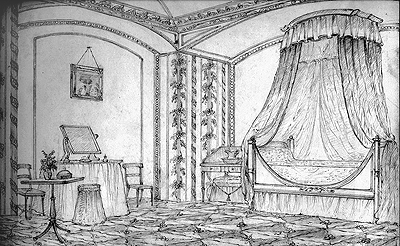The two second floor bedrooms were private family rooms and so were not finished as sumptuously as those on the ground and first floors, though they still provided spacious accommodation with a high level of comfort. Typically, main bedrooms had panelled doors and matching panelling underneath the windows, together with relatively plain cornices and skirting boards. The rooms would usually be wallpapered; a note on the plan of a house built in Brunswick Square for Charles Elliott allows 8d, or eight old pence, per roll. The main features of the room would be the sumptuous furnishing and fabrics which often included very elaborate coordinated curtains and bed hangings.

It was usual for the master and the mistress of the house to each occupy one of these rooms which could be linked to form a suite. Adjacent to the 'best bedroom' at the front of the house was a small dressing room. This could also be accessed by the occupant of the rear bedroom by a separate doorway on the landing.

Above: Drawing of 'the best bedroom' in a Regency home.
The top floor rooms were most often used by junior family members and household staff. The top floor of The Regency Town House was divided into five rooms. The front two bedrooms have simple cornices and architraves and were probably used by family members, while the remaining three rooms had no sophisticated decoration, suggesting their use by servants. Of these, two appear to form an interconnecting suite indicating their possible use as a nursery.